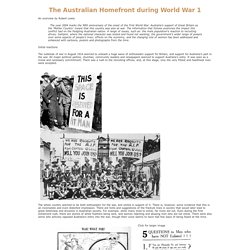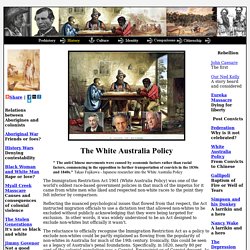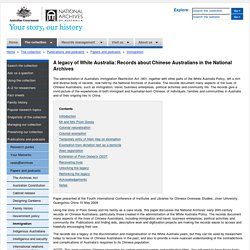

WWI: Love & Sorrow Exhibition at Melbourne Museum World War I in Photos: Technology. First Australian Imperial Force. Formation[edit] Hastily deployed, the first contingent of AIF was essentially untrained and suffered from widespread equipment shortages.

In early 1915 the AIF was largely an inexperienced force, with only a small percentage of its members having previous combat experience. However, many officers and non-commissioned personnel (NCOs) had previously served in the pre-war permanent or part-time forces, and a significant proportion of the enlisted personnel had received some basic military instruction as part of Australia's compulsory training scheme. Predominantly a fighting force based on infantry battalions and light horse regiments—the high proportion of close combat troops to support personnel (e.g. medical, administrative, logistic, etc.) was exceeded only by the New Zealand Expeditionary Force (NZEF)—this fact at least partially accounted for the high percentage of casualties it later sustained. Organisation[edit] Command[edit] Structure[edit] Infantry divisions[edit] Corps[edit] Cartoons of the Moment – The Economy in Germany (c1915) clip 1 on ASO. Clip description This clip begins with the title card Cartoons of the Moment followed by a scene of cartoonist Harry Julius sketching at an easel.

A group of children run up to him and watch as he sketches. The three animated political sketches that follow comment on the economy in Germany during the First World War. In the first sketch, German policeman PC Von Fritz arrests a fashionably dressed woman and replaces her clothes with newspaper. In the second, a schoolmaster encourages his student to eat slowly so he’ll think it is a lot of food. Curator’s notes This sketch is representative of the style and tone of cartoonist Harry Julius’s political satire. Julius is often shown sitting at his desk reading a current newspaper before sketching down his ideas. Cartoons of the Moment – Miss Australasia (c1915) clip 1 on ASO.
The Australian Home Front during World War 1 - Women s role and place. Women’s role and place At the outbreak of war far fewer women than men participated in work, and these tended to be in lower-paid occupations.

Women’s main role was seen to be in the home. The withdrawal of about half a million men most of whom had been in the workforce did not, however, result in their direct replacement by women. Women’s contribution to the workforce rose from 24 per cent of the total in 1914 to 37 per cent in 1918, but the increase tended to be in what were already traditional areas of women’s work - in the clothing and footwear, food and printing sectors. There was some increase also in the clerical, shop assistant and teaching areas.
Cartoon from 'The Worker' 10 February 1916. Many women sought to become more involved in war-related activities - such as cooks, stretcher bearers, motor car drivers, interpreters, munitions workers - but the government did not allow this participation. Copyright © ANZAC Day Commemoration Committee (Qld) Incorporated. The Australian Home Front during World War 1. An overview by Robert Lewis The year 2004 marks the 90th anniversary of the onset of the First World War.

Australia’s support of Great Britain as the ‘Mother Country’ meant that this country was also at war. The information that follows examines the impact this conflict had on the fledgling Australian nation. A range of issues, such as: the male population’s reaction to recruiting drives; Gallipoli, where the national character was tested and found not wanting; the government’s wider range of powers over some aspects of people’s lives; effects on the economy, and the changing role of women has been addressed and enhanced with cartoons, posters and photographs from the time. Initial reactions. White Australia Policy - From Convicts to Chinese. " The anti-Chinese movements were caused by economic factors rather than racial factors, commencing in the opposition to further transportation of convicts in the 1830s and 1840s.

" Takao Fujikawa - Japanese researcher into the White Australia Policy The Immigration Restriction Act 1901 (White Australia Policy) was one of the world's oddest race-based government policies in that much of the impetus for it came from white men who liked and respected non-white races to the point they felt inferior by comparison. Reflecting the nuanced psychological issues that flowed from that respect, the Act instructed migration officials to use a dictation test that allowed non-whites to be excluded without publicly acknowledging that they were being targeted for exclusion. In other words, it was widely understood to be an Act designed to exclude non-whites but officially it wasn’t. Immigration. The administration of Australia's Immigration Restriction Act 1901, together with other parts of the White Australia Policy, left a rich and diverse body of records, now held by the National Archives of Australia.

The records document many aspects of the lives of Chinese Australians, such as immigration, travel, business enterprises, political activities and community life. The records give a vivid picture of the experiences of both immigrant and Australian-born Chinese, of individuals, families and communities in Australia and of their ongoing ties to China. Paper presented at the Fourth International Conference of Institutes and Libraries for Chinese Overseas Studies, Jinan University, Guangzhou China 10 May 2009.
Scanned information from the text Was it only Yesterday- insights into life at home during WW1. Australia & WWI.